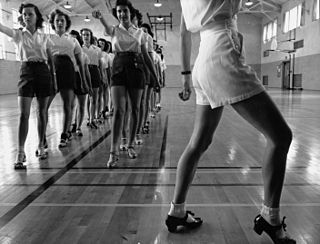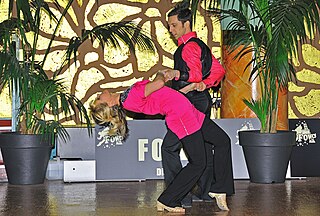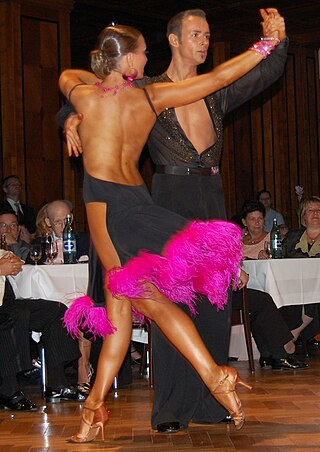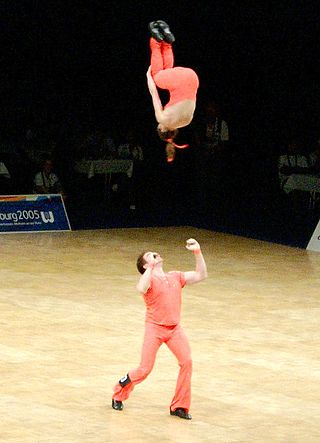
East Coast Swing (ECS) is a form of social partner dance. It belongs to the group of swing dances. It is danced under fast swing music, including lindy hop, rock and roll and boogie-woogie.
Jazz dance is a performance dance and style that arose in the United States in the mid 20th century. Jazz dance may allude to vernacular jazz, Broadway or dramatic jazz. The two types expand on African American vernacular styles of dance that arose with jazz music. Vernacular jazz dance incorporates ragtime moves, Charleston, Lindy hop and mambo. Popular vernacular jazz dance performers include The Whitman Sisters, Florence Mills, Ethel Waters, Al Minns and Leon James, Frankie Manning, Norma Miller, Dawn Hampton, and Katherine Dunham. Dramatic jazz dance performed on the show stage was promoted by Jack Cole, Bob Fosse, Eugene Louis Faccuito, and Gus Giordano.
In some types of partner dance, lead and follow are designations for the two dancers' roles in a dance pairing. The leader is responsible for guiding the couple and initiating transitions to different dance steps and, in improvised dances, for choosing the dance steps to perform. The leader communicates choices to the follower, and directs the follower by means of subtle physical and visual signals, thereby allowing the pair to be smoothly coordinated.

Tap dance is a form of dance which uses the sounds of tap shoes striking the floor as a form of percussion; it is often accompanied by music. Tap dancing can also be a cappella, with no musical accompaniment; the sound of the taps is its own music.

West Coast Swing is a partner dance with roots in Lindy Hop. It is characterized by an elastic look that results from its extension-compression technique of partner connection and is danced primarily in a slotted area on the dance floor. The dance allows for both partners to improvise steps while dancing together, putting West Coast Swing in a short list of dances that emphasize improvisation.

Swing dance is a group of social dances that developed with the swing style of jazz music in the 1920s–1940s, with the origins of each dance predating the popular "swing era". Hundreds of styles of swing dancing were developed; those that have survived beyond that era include Charleston, Balboa, Lindy Hop, and Collegiate Shag. Today, the best-known of these dances is the Lindy Hop, which originated in Harlem in the early 1930s. While the majority of swing dances began in African-American communities as vernacular African-American dances, some influenced swing-era dances, like Balboa, developed outside of these communities.
Swing Rueda is a swing dance in the round (wheel) that features someone calling Lindy Hop moves and the dancers moving in unison. It was adapted from Salsa Rueda by Elaine Hewlett and Jeff Miller at The Rhythm Room Dance Studio, Dallas, Texas in 2000.

Partner dances are dances whose basic choreography involves coordinated dancing of two partners, as opposed to individuals dancing alone or individually in a non-coordinated manner, and as opposed to groups of people dancing simultaneously in a coordinated manner.
The Big Apple is both a partner dance and a circle dance that originated in the Afro-American community of the United States in the beginning of the 20th century.
A Coaster Step is a term used in swing dancing which originated in Lindy swing. During the last two beats of a rhythm pattern, the follower rotated 90° to be perpendicular to the leader, then stepped back, together, and forward in triple-rhythm, then rotated back to face the leader and to be ready to step forward as the leader led the follower in to begin the next pattern.

Acrobatic rock and roll is a fast, athletic, physically demanding form of partner dance that originated from Lindy Hop but has evolved to a choreographed sport, often done in formal competition. It is danced by both couples and groups, either all-female or four to eight couples together.
The country/western two-step, often called the Texas two-step or simply the two-step, is a country/western dance usually danced to country music in common time. "Traditional [Texas] two-step developed, my theory goes, because it is suited to fiddle and guitar music played two-four time with a firm beat [found in country music]. One-two, one-two, slide-shuffle. The two-step is related to the polka, the Texas waltz, and the jitterbug.
The Texas two-step is the same step known to ballroom dancers as the international fox-trot. Except for the one-step, which is just that, most Texas dances are variations of a two-step, also called a half-step, which is simply a step-close-step. The Texas two-step is generally done with two long steps and a step-close-step to two-four time. Speeded up, it's a shuffle or double shuffle, but still a two-step.
Rock step may refer to one of several similar dance moves. The name refers to the rocking action during the move: the weight is transferred from one foot to another and then back. It is used in a number of dances, such as East Coast Swing, Zydeco, Lindy Hop, Tango.
St. Louis shag is a swing dance that evolved from the Lindy Hop, Collegiate Shag and Charleston. It is a fast, closed position dance that is usually done to stomp, jump, and boogie-woogie music.
Chicago-Style Stepping is an urban dance that originated in Chicago and continues to evolve nationwide and overseas, while defining its unique style and culture. within urban community. "Chicago-Style Stepping" makes reference to other urban styles of dance found throughout the United States in urban enclaves such as Detroit, Cleveland, Baltimore and Washington, D.C.
The promenade position is a dance position in ballroom and other dances. It is described differently in various dance categories.

The Lindy Hop is an American dance which was born in the African-American communities of Harlem, New York City, in 1928 and has evolved since then. It was very popular during the swing era of the late 1930s and early 1940s. Lindy is a fusion of many dances that preceded it or were popular during its development but is mainly based on jazz, tap, breakaway, and Charleston. It is frequently described as a jazz dance and is a member of the swing dance family.
The Collegiate Shag is a partner dance done primarily to uptempo swing and pre-swing jazz music. It belongs to the swing family of American vernacular dances that arose in the 1920s and 30s. It is believed that the dance originated within the African American community of the Carolinas in the 1920s, later spreading across the United States during the 1930s. The shag is still danced today by swing dance enthusiasts worldwide.








